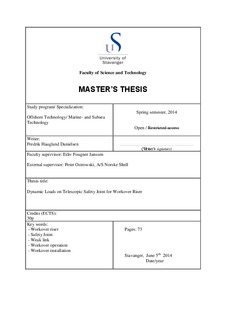| dc.contributor.author | Fredrik Haugland, Danielsen | |
| dc.date.accessioned | 2014-09-15T07:40:40Z | |
| dc.date.available | 2014-09-15T07:40:40Z | |
| dc.date.issued | 2014-06-05 | |
| dc.identifier.uri | http://hdl.handle.net/11250/219681 | |
| dc.description | Master's thesis in Offshore technology | nb_NO |
| dc.description.abstract | The push in the industry towards increasing the weather window for marine operations offshore leads to a focus on new technology. When performing workover operations in a subsea well, the workover riser is a physical connection between the well and the floating workover vessel. A floating vessel will experience wave induced motion and is therefore equipped with a heave compensator to allow for this relative motion without increasing the load to the riser. If the heave compensator fails or if the heave of the vessel exceeds the stroke length of the heave compensator, the workover riser can be subjected to an excessive axial force that could rupture the riser and damage subsea well barriers.
A safety joint that is to be installed in the riser can improve the window for safe operation while reducing consequences if an accident were to occur. It is called the Telescopic Safety Joint (TSJ) and has been developed by FMC Technologies. The joint is designed to telescope when subjected to a predetermined axial force. The telescoping function of the joint will ensure that there is sufficient time for personnel onboard the vessel to activate the emergency disconnect function so that the riser can safely be disconnected from the well.
The safety joint is a weak link. During installation of the workover system, the riser experiences loading conditions exceeding that of normal operation. There is a concern that the safety joint may take plastic damage during this installation. Hence the TSJ is equipped with an over-ride function that temporarily can increase the strength of the joint. The over-ride function works by pumping hydraulic pressure into external cylinders. The increase in the strength of the joint from the over-ride function depends upon the hydraulic pressure. This thesis studies the effect the over-ride function has on the weather window for installation of a workover system, comparing a fully pressurized over-ride function to a semi-pressurized over-ride function.
Simulations in Orcaflex for various environmental conditions found the loads that the TSJ must be able to withstand for installation to be possible. A model of the joint was created in AUTODESK Inventor. Using ANSYS workbench, the model was tested to find out which loads that are acceptable and which loads leads to plastic damage of the joint both for the fully pressurized and semi-pressurized over-ride function.
Combining the results for the fully- and semi-pressurized over-ride function test, with the results from the dynamic simulations performed in Orcaflex revealed an increase in installation window when using the fully pressurized over-ride function. The joint using the full capacity of the over-ride function was able to withstand 620kNm before plastic damage took place. The joint using a semi-pressurized over-ride function began taking plastic damage at 400kNm. The over-ride function increases the bending moment capacity of the joint by 55%. Using the scatter diagram for the Draugen field to see how many observations has been made of the different sea states, the increased availability for installation when using the full capacity of the over-ride function, as opposed to the semi-pressurized joint was calculated. When installing the TSJ as the 2nd riser joint, the availability increased by 21,7%. Installing the TSJ as the 3rd joint increases the availability by 16,7%. Installation of the TSJ on the 4th and 5th joint gives an increase of respectively 2,8% and 0,3% when the full over-ride capacity is used. The over-ride functions proved to be so effective that the joint became stronger than the actual workover riser. Hand calculations showed that the riser would yield before the safety joint and thus the safety joint would not be a limiting factor for the workover installation activity if the over-ride function is active. | nb_NO |
| dc.language.iso | eng | nb_NO |
| dc.publisher | University of Stavanger, Norway | nb_NO |
| dc.relation.ispartofseries | Masteroppgave/UIS-TN-IKM/2014; | |
| dc.subject | workover riser | nb_NO |
| dc.subject | safety joint | nb_NO |
| dc.subject | weak link | nb_NO |
| dc.subject | workover operation | nb_NO |
| dc.subject | workover installation | nb_NO |
| dc.subject | offshore teknologi | nb_NO |
| dc.subject | undervannsteknologi | nb_NO |
| dc.title | Dynamic loads on telescopic safety joint for workover riser | nb_NO |
| dc.type | Master thesis | nb_NO |
| dc.subject.nsi | VDP::Technology: 500::Marine technology: 580::Offshore technology: 581 | nb_NO |
